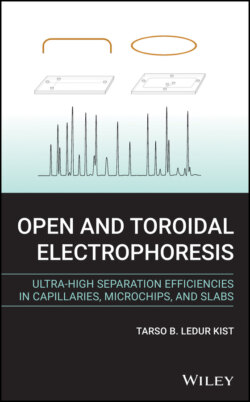Читать книгу Open and Toroidal Electrophoresis - Tarso B. Ledur Kist - Страница 23
1.1.11 Henderson–Hasselbalch Equation
ОглавлениеRearranging the terms on the right hand side of equations 1.14 and 1.15, as well as applying the “” operator to them, produces the following:
(1.16)
Figure 1.5 p–pH diagram of citric acid species in an aqueous solution. The conditions are identical to those used in Figure 1.4. Here, however, the concentration of the species can be seen for broader ranges.
Within diluted solutions, the activities can be replaced by to give . Therefore:
(1.17)
These equations are very useful for the preparation of buffer solutions with a given pH. One way to prepare a buffer solution is by adding a strong base to a solution that contains a weak acid dissolved in it. The concentration of will be negligible if compared to (amount of initial weak acid) before the addition of the strong base. This comes from the definition of a weak acid. Therefore, the addition of mol of a strong base to a solution containing mol of a weak acid will result in mol of A− ions, and mol of HA molecules will be left in the solution. The resulting pH will then be given by: , with the condition that . On the other hand, if the weak acid is not so weak (or the weak base is not so weak) then the final pH will be slightly lower (or higher) than predicted. This occurs because extra A− ions, and consequently some H+ ions, come from the self-ionization of the acid itself and not just from the added strong base (or strong acid).
Besides precise pHs values, the buffer capacity of a given buffer solution is also a very important parameter as it indicates how good the buffer is at keeping the pH nearly constant throughout the addition of a small quantity of a strong acid or base. Section 1.1.12 shows that the highest buffer capacities of monoprotic acids are observed for pH values close to . The maximum buffer capacity of a multiprotic acid can be visualized by plotting its buffer capacity against pH (also shown in Section 1.1.12). Finally, equation 1.17 can be arranged into the more useful format:
(1.18)
where are the number of moles of a strong base (strong acid) that must be added to a solution containing moles of a weak acid (weak base), characterized by , to obtain a final solution with the desired pH. This can then be diluted until the desired concentration is achieved. The ideal situation is to have: , as shown in Section 1.1.12.
Equation 1.18 will still be valid for multiprotic acids or molecules bearing a mixture of acidic and basic functional groups (zwitterionic compounds or zwitterions) if their values are separated from each other by at least two units. Examples of such molecules include most proteinogenic amino acids and linear peptides without ionizable lateral chain residues. Within some pH ranges, however, if the values are less than two units apart then two or more anions (or cations) from the same acid (or base) will start to coexist at concentration of more than 1% of the total molar concentration of the initial acid (or base). In this case the idea of separately visualizing conjugated acids and bases becomes a little bit confusing as the same species may start to play both roles. This is well demonstrated within the c–p and p–p diagrams. Luckily, buffer capacity (see Section 1.1.12) can still be calculated and measured under these circumstances ( values, which are less than two units apart from each other).
